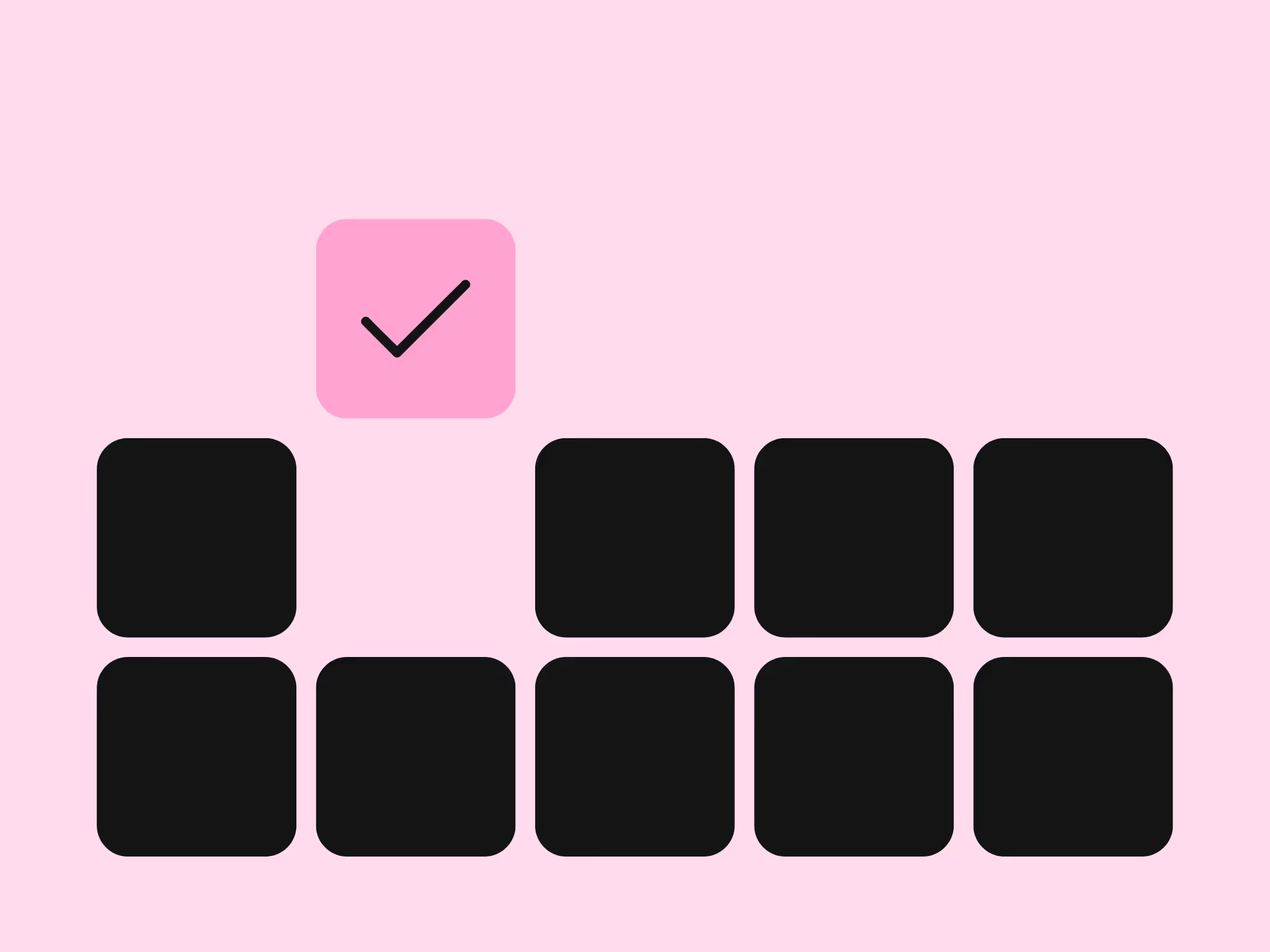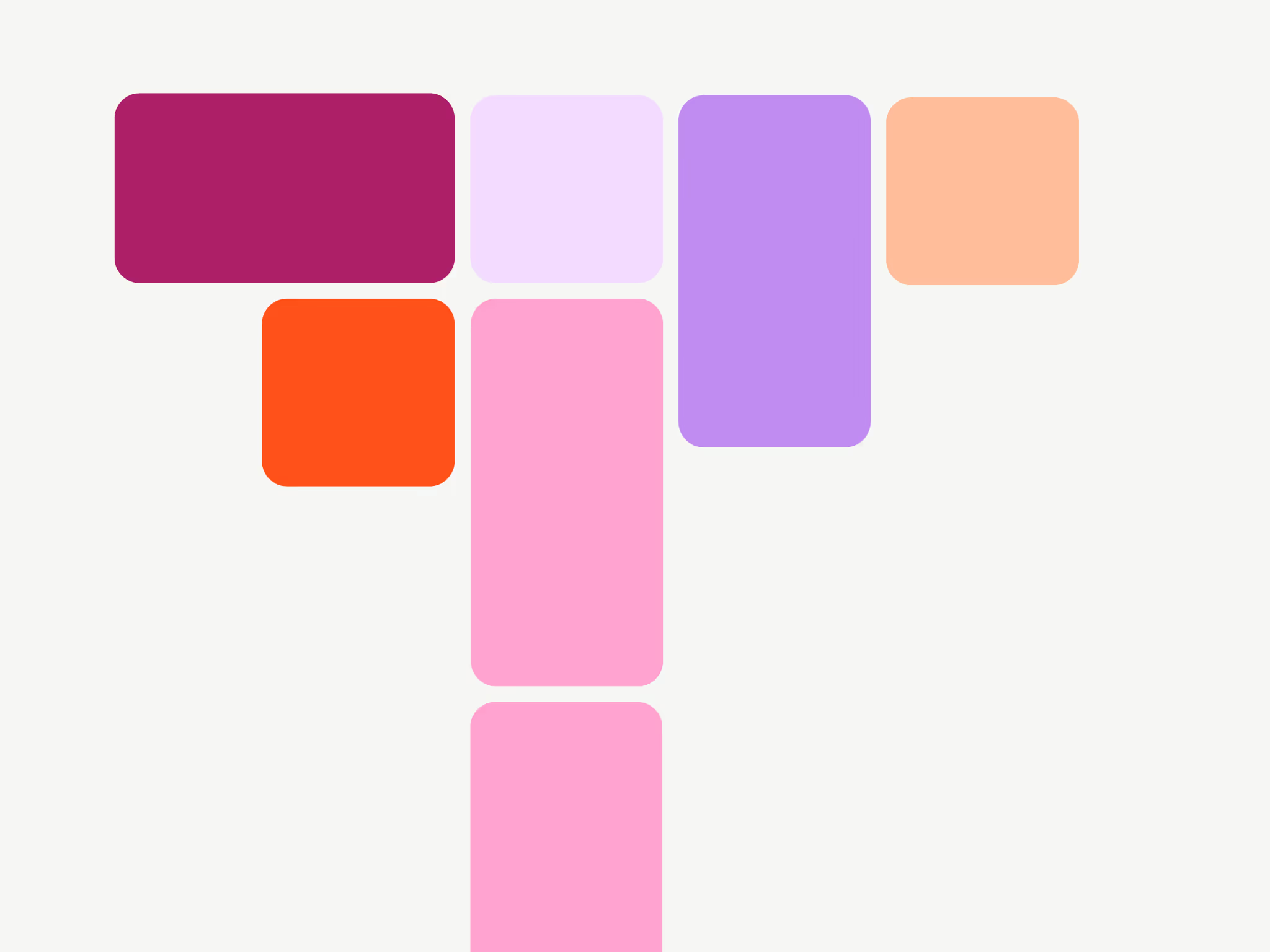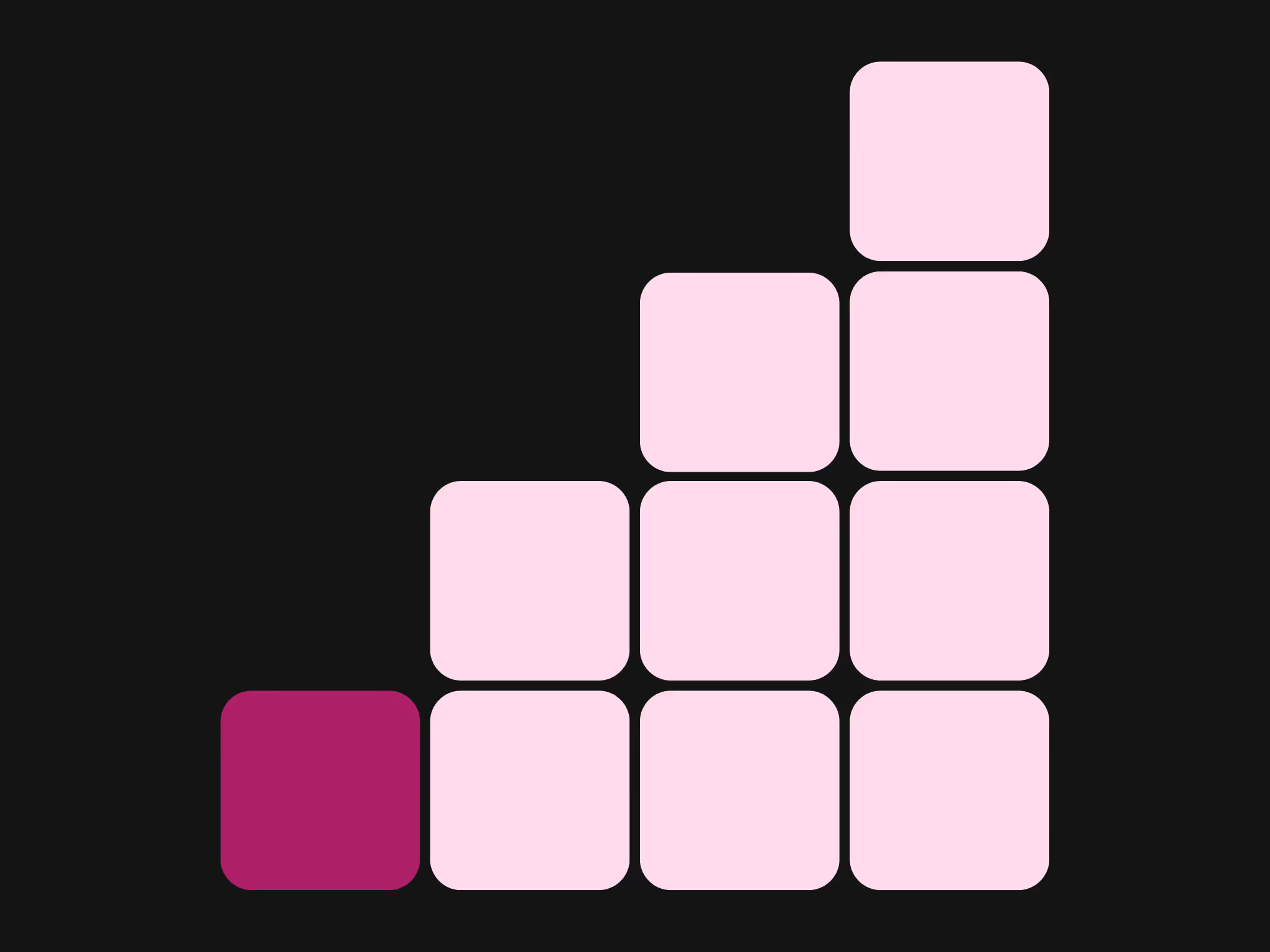Finding new influencers doesn’t feel as easy as it used to.
You put in your tried-and-true keywords and hashtags. You scroll through hundreds of the same faces you’ve already seen (and worked with).
Anyone new you reach out to seems to already be working with a competitor, under exclusivity, or demanding fees that haven’t even heard of your budget.
You’ve found all the influencers in the world. What now?
I spoke to 56 marketers about how they actually find influencers, and what they’re looking for. I found a lot of marketers want to think outside the box, but it’s not as easy as it looks.
Marketers say finding the right influencers is getting too hard
A whopping 87.5% of marketers I polled told me that it’s getting more difficult to find that perfect fit influencer for their campaigns. Nearly everyone we polled feel like they’re just hitting a wall when it comes to their searches.
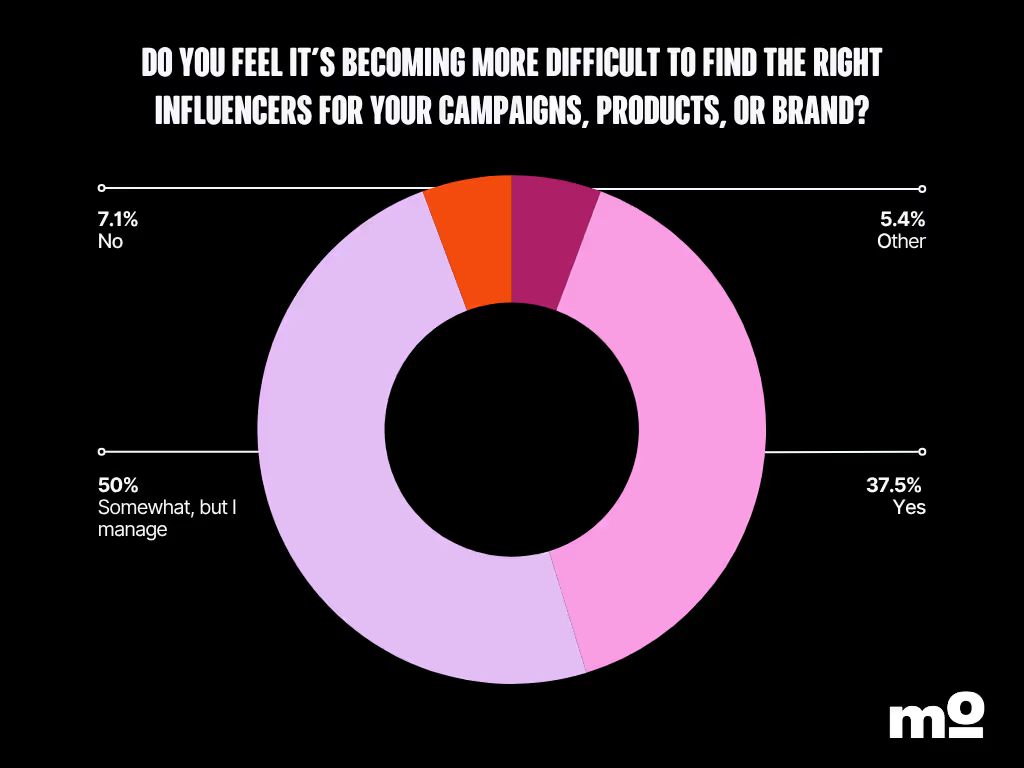
But why? There are more influencers than ever before. In theory, there should be plenty of fish in the sea.
According to the marketers I spoke to :
- There are too many low-quality influencers (where the content just isn’t polished enough, or they’re inconsistent, or their metrics aren’t there).
- The influencers they do find aren’t open to their collaboration type (i.e. gifting), or they’re way out of budget.
- They lack the time and resources necessary to search and properly vet their influencers.
Fernanda Marques says that it’s hard when you get so deep within your own niche.
According to Damini Gulati, there’s just no one left.
Is it really getting harder – or are marketers getting pickier?
Nearly 2/3rds of marketers said they’d felt like they’d missed out on an interesting potential collaboration because an influencer didn’t hit all of their criteria.
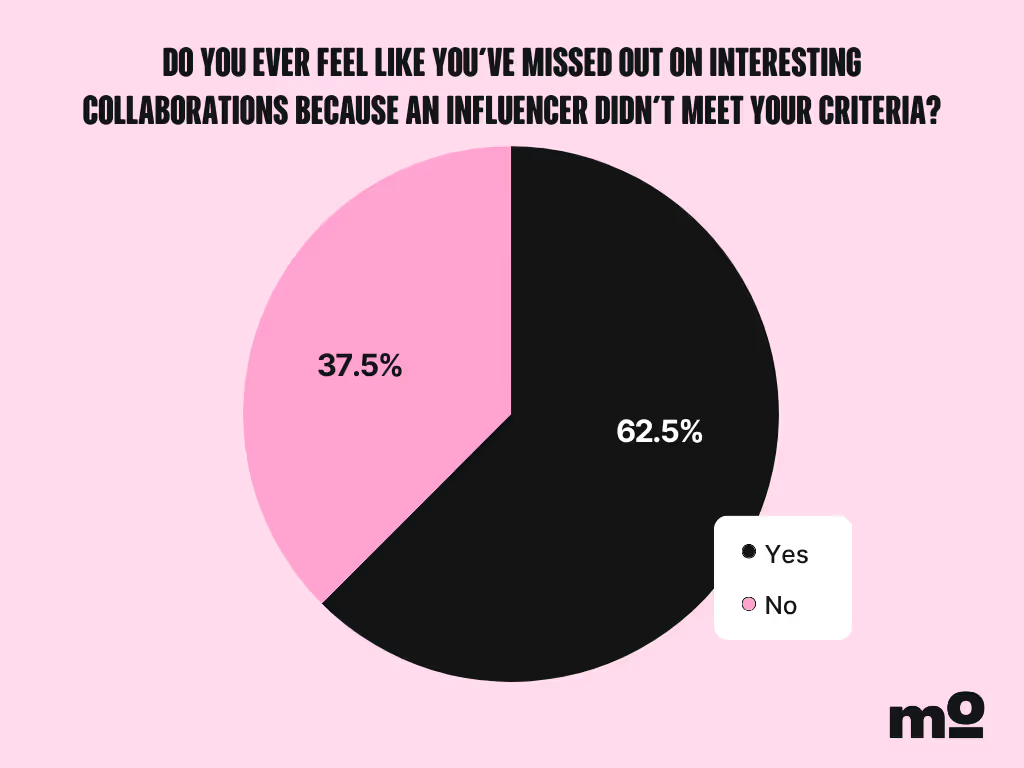
So which criteria was the collab-killer culprit? Most of the time, it boiled down to metrics – most specifically, audience metrics.
Audience metrics, perhaps, is the one criteria you wouldn’t want to budge on. After all, if an influencer isn’t speaking to the people you’re trying to target, it doesn’t really make sense to move forward.
But surely audience demographics wasn’t the only thing knocking influencers out of the running. While market saturation is 100% a thing and it can definitely happen if your niche is small or restricted, I had a feeling that this wasn’t the whole story.
Is there really no one left, or was there no one left that fit into a shopping list of criteria?
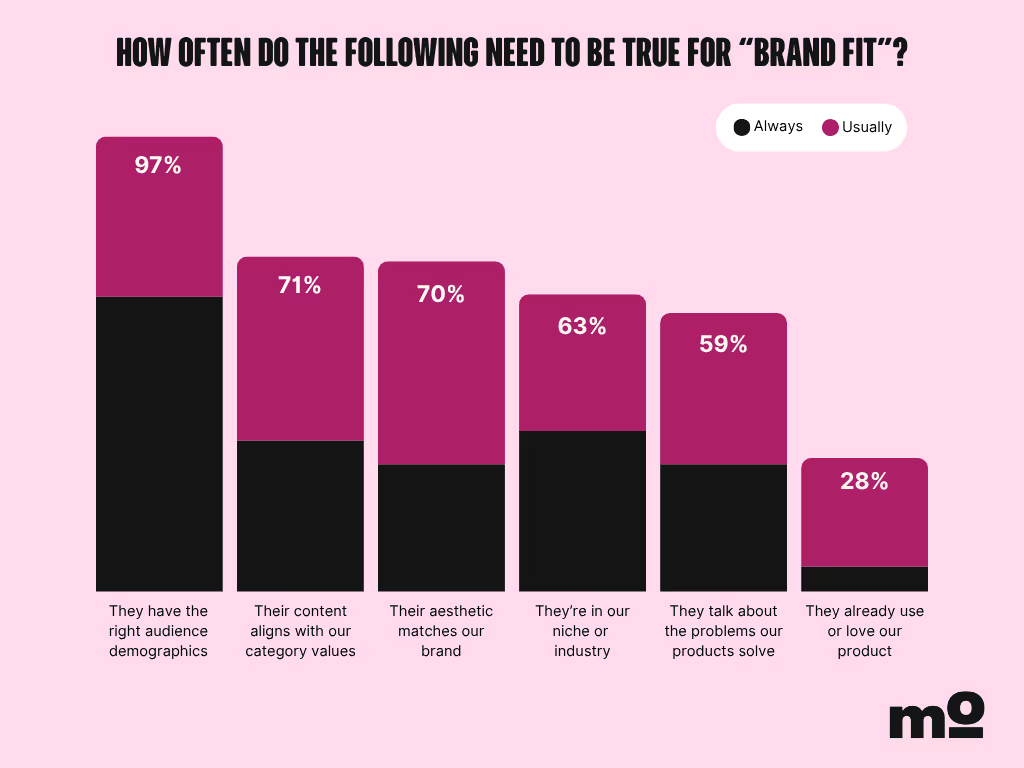
I asked marketers how often a set of statements needed to be true for an influencer to fit into their definition of “brand fit.” Aside from those who already use or love their products, the grand majority said that each statement was either always or usually true.
Meaning that not only does an influencer have to have the right audience demographics, they also have to:
- Create content that aligns with the brand’s category values
- Have an aesthetic that matches a brand
- Create content that’s in a brand’s particular niche or category
- Already talks about the problems a brand’s products solve
Plus, I asked marketers what was missing from those statements, and got a laundry list of even more criteria that an influencer needed to hit to even be on their radars.
Influencers also need to:
- Have a high engagement rate
- Have a hyper-local following
- Be modest, have a clean past, and no collabs with sketchy companies/industries
- Be good sellers with good hooks and nice voices
- Not work with competitors or promote low-category brands
- Have fun energy, and be unique
None of those things are necessarily bad things to look for or want. However, if all of these things are must-haves, that reduces your pool of potential influencers by a lot.
Lauren Roth mentions that sometimes, brands focus on the wrong metrics.
Some marketers say that sometimes, an influencer looks great on paper, but presents too much of a brand risk to move forward – like a background check that doesn’t come back clean, or sexual or political content popping up.
For other brands, if the ✨aesthetic ✨ isn’t there, it’s a full stop. Paulina Cieślik highlights that this has been her experience in working with some brands who focused on aesthetics first.
Overfitting: Storyfit vs Productfit – Which is better?
We could call this overfitting. Overfitting is the idea that you have to find that unicorn-style influencer that meets each and every criteria on your shopping list.
What I found in this survey is that a lot of people seemed to focus on a product fit over a storyfit.
- Product fit is when someone fits nice and neatly into a niche, where they talk about similar products, have worked with non-threatening competitors, or they fit into the people you’d normally go for. They’re The Obvious Choice™.
- Storyfit is when you have someone who is great at telling your brand’s story. They’re masters of weaving narratives, and it’s not the first person you’d necessarily think of when looking for a new influencer.
Neither one is necessarily better than the other – it’s just that product fit is obvious. That means that:
- Your competitors have worked with them before
- There’s a certain level of predictability around the content you’re getting back
- Higher demand means they might be more expensive
A storyfit influencer can be someone unlike anyone you’ve ever worked with – but their content exists in a moment where your brand story is going to make the biggest impact. They might be a little rougher around the edges. Maybe their content is very one-shot with their phone in 10 minutes, but it comes off authentically. It feels real.
Marketers were more likely to experiment with unconventional, storyfit influencers (51.8%) when they were running brand awareness campaigns. However, for sales campaigns, most preferred to stick to product-fit influencers in their niche (69.6%).
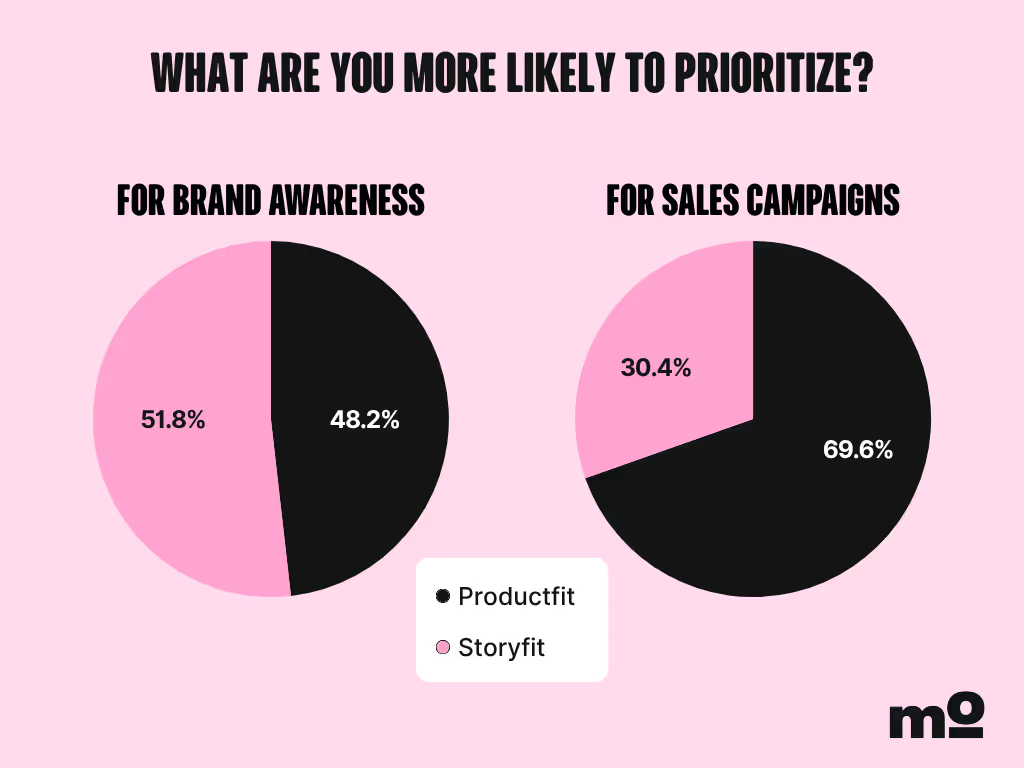
However, storyfit influencers can and do convert – and sometimes, they do so better than your average product fit influencers.
At Modash, internally, we call this idea “lamp influencers.” It’s when you sell lamps, and so you’re looking for a lamp influencer. But there aren’t actually a ton of lamp influencers.
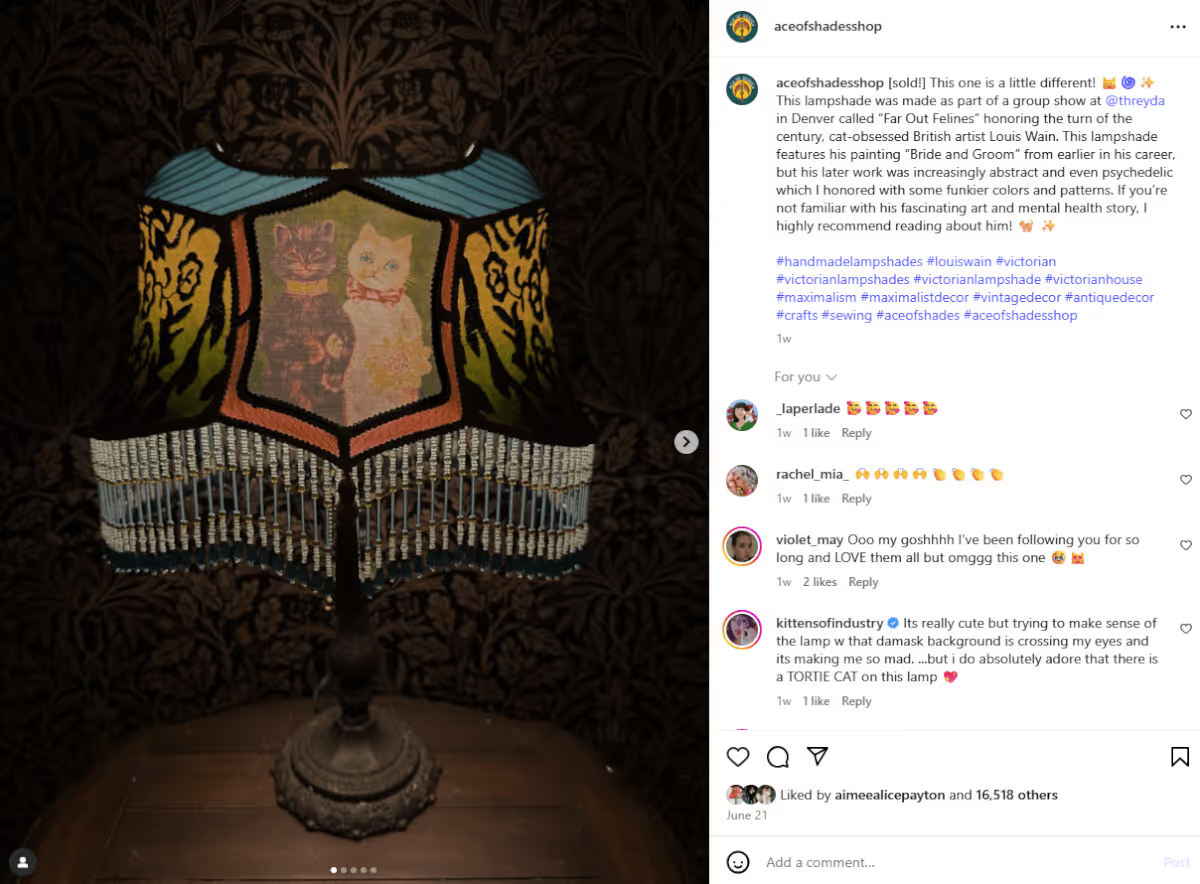
Unless you’re @AceofShades, I guess.
And if you’re finding that your search is limited because “I sell X so my influencer also needs to sell X,” storyfit creators might be the best way to solve search issues.
Kat LaFata offers ways to stay creative.
She goes on to suggest examples:
- Household cleaning products: Target makeup girlies talking about getting foundation stains out of the carpet/upholstery/clothes
- Finance apps: Target fashion influencers showing how they use the app to invest the cash they get selling unique vintage label items
While influencers like these might not be the first ones to spring to mind, they’ll be able to better communicate the need to purchase your products to their audience. They might have use-cases you didn’t even know existed. They can tell the story.
The Storyfit Effect
Not only does thinking about a storyfit influencer wildly open your potential pool of creators, but these creators aren’t The Obvious Choice™. This means:
- They are less likely to be overbooked by your competitor, or out of budget
- They’ll probably fall into a niche audience that is highly engaged.
And this isn’t just theory. Nearly 3 in 4 marketers said they’d worked with a creator that was an on-paper mismatch but overperformed.
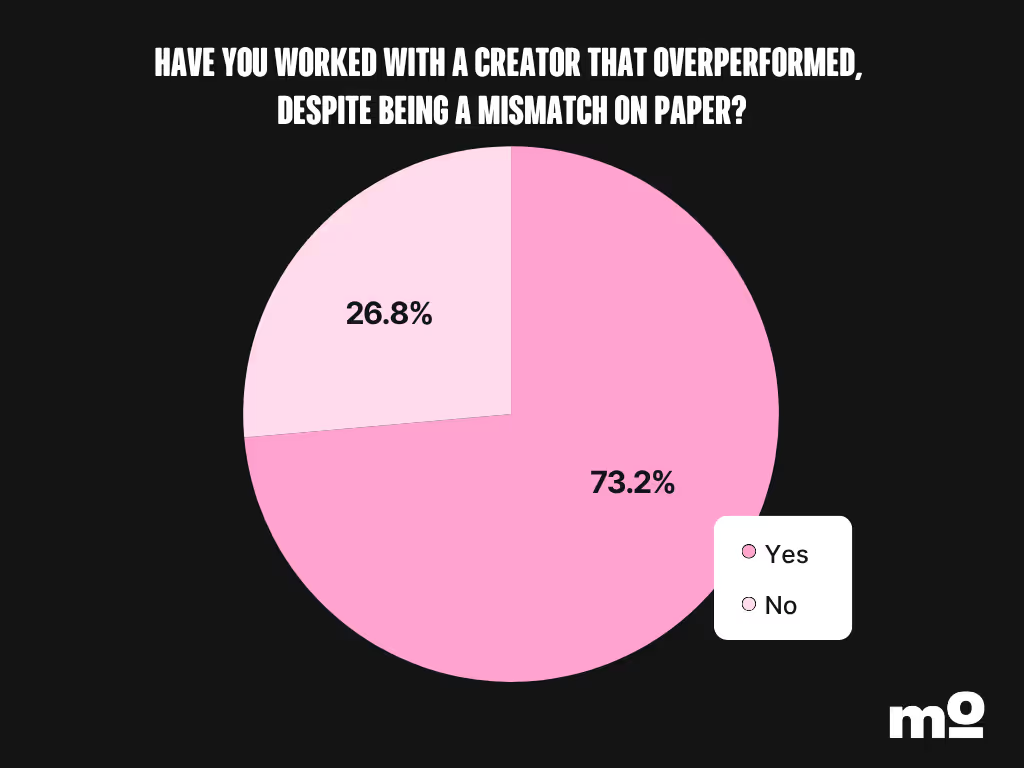
So where did wiggle room make sense for these marketers?
Age: For example, a lot of marketers highlight that their companies or the brands they work with tend to have general age requirements for their influencers. Nacho Selma took a chance on a younger influencer who ended up outperforming everyone else he’d hired.
Quality: Sometimes, content quality may be a little rougher for smaller, niche influencers. But if it resonates with their audience, try to roll with it. Andrea Pavić said that she worked with a creator who was “unprofessional” on paper, but sold well.
Metrics: I know what I said. “Don’t compromise on audience metrics.” Yes, but. Hear me out. Or, rather, hear Lee Drysdale out. He followed his gut with an influencer whose metrics weren’t quite there – and had great results.
✨Aesthetic✨: Sometimes, an influencer’s personal style isn’t going to exactly fit a brand’s idea for what makes a good match. Abdullah Khan highlights that sometimes, if an influencer’s values are in line, aesthetic might be worth compromising on.
He continues:
Sometimes, having a little flexibility around who you hire can make all the difference.
How do I find story-fit creators?
We have a more in-depth explanation of how to find storyfit influencers, but here’s a quick run-down.
Start from three core concepts:
- Category Entry Points (CEPs): CEPs are real-life emotional triggers your customer feels when they say “I could use something like that.” Creators who are CEP fits create content in a moment in time where your product solves a problem a customer has.
- Identity: Creators who embody your customers’ values, lifestyle, or goals – even outside of your particular niche. Your customers want to be them. They see themselves in these creators.
- Format: Creators have a unique style that makes them one in a million – whether it’s their humor, dramatic reenactments, emotional authenticity or vulnerability, chaotic energy, etc. They’ll be able to reframe your product and brand in a refreshing way.
.avif)
Instead of thinking about product or niche fit, or going after The Obvious Choice™, you’re doing something much more strategic: You’re making your customer the hero of the story, instead of yourself.
And when your customer is the hero, that’s where the magic happens.
Beth Cortez agrees that sometimes those unexpected on-paper misfits can surprise you.
My advice? Die on the following hills:
- Reach: Are they actually engaging anyone?
- Relevance: Are they speaking to the right people?
- Resonance: Will their message land emotionally?
Be flexible on the other stuff:
- Aesthetic
- Content quality (but not authenticity)
- Age/demographics of the influencer themselves
Again, I’m not saying storyfit influencers are better than product fit influencers. I’m saying that if you’re hitting a wall with The Obvious Choice™, thinking about storyfit is going to open up the pool significantly. All you have to do is take those blinders off, and give them a shot.
They might just surprise you.
How influencer search needs to evolve
Influencer marketing is changing – and influencer search needs to adapt in the same way.
But, for the majority of marketers, if that perfect story-fit influencer falls into their laps, and there’s extra budget, and it’s not a sales campaign, and the planets align…
…only then will they actually experiment with new, unconventional creators.
And if all that needs to be true to even consider working with storyfit creators, it’s hard to justify dedicating resources and brain power into how to even look for them.
But, it’s not hard. Start from your baseline audience metrics. Use the 80/20 rule – if an influencer hits 80% of those hard metrics criteria, that’s probably going to be good enough.
And as far as starting from audience metrics – Modash can help. Modash search is sophisticated – but still easy to use. This means you can plug in what’s most important to you, and turn up a list of everyone (and yes, I do mean everyone) who fits the bill.
But don’t take my word for it. Try Modash free for 14 days (without even pulling out your credit card).


